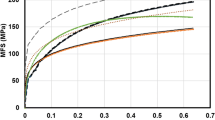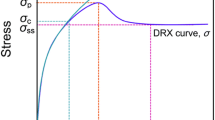Abstract
This work extends the application of the well-established Estrin and Mecking (EM) work-hardening model in unstable low temperature austenite region. The interaction between work hardening, recovery and softening attributed to recrystallization and transformation to ferrite under dynamic conditions is considered. Experimental parameters were varied to study the effects of strain, strain rate and temperature during hot rolling in the low temperature austenite region. Hot compression tests were performed two microalloyed steels—one containing V and the other Nb—at strain rates between 0.1 and 10 s−1 over a temperature range of 750-1000 °C. A model is presented that describes the influence of dynamic recovery on flow behavior in the unstable austenite region. The modified work-hardening model incorporates an additional fitting parameter to the EM model and is dependent on the recovery and softening rates. The new model improved prediction in the unstable austenite region, while the original EM model gave better correlation at relatively higher temperatures when dynamic recrystallization is dominant or at relatively lower temperatures when only dynamic recrystallization to ferrite was the softening mechanism.








Similar content being viewed by others
References
O. Bouaziz, Revisited Storage and Dynamic Recovery of Dislocation Density Evolution Law: Toward a Generalized Kocks-Mecking Model of Strain-Hardening, Adv. Eng. Mater., 2012, 14(9), p 759–761
A. Momeni, S.M. Abbasi, and H. Badri, Hot Deformation Behaviour and Constitutive Modelling of VCN 200 Low Alloy Steel, Appl. Math. Model., 2012, 36, p 5624–5632
M. Meysami and S.A.A.A. Mousavi, Study on Behaviour of Medium Carbon Vanadium Microalloyed Steel by Hot Compression Test, Mater. Sci. Eng. A, 2011, 528, p 3049–3055
H.-L. Wei, G.-Q. Liu, X. Xiao, and M.-H. Zhang, Dynamic Recrystallization Behavior of a Medium Carbon Vanadium Microalloyed Steel, Mater. Sci. Eng. A, 2013, 573, p 215–221
H. Mirzadeh, J.M. Cabrera, J.M. Prado, and A. Najafizadeh, Hot Deformation Behaviour of a Medium Carbon Microalloyed Steel, Mater. Sci. Eng. A, 2011, 528, p 3876–3882
P.D. Hodgson, L.X. Kong, and C.H.J. Davies, The Prediction of the Hot Strength in Steels with an Integrated Phenomenological and Artificial Neural Network Model, J. Mater. Process. Technol., 1999, 87, p 131–138
S.A.J. Chalimba, R.J. Mostert, W. Stumpf, K.M. Banks, C.W. Siyasiya, Effects of Roughing on Finish Rolling Simulations in Microalloyed Strip Steels. J. Mater. Eng. Perform. (Accepted for publication, 2017)
B. Roebuck, J.D. Lord, M. Brooks, M.S. Loveday, C.M. Sellars, and R.W. Evans, Measurement Good Practice Guide No 3—Measuring Flow Stress in Hot Axisymmetric Compression Tests, National Physical Laboratory, United Kingdom, 2002
C. Devadas, D. Baragar, G. Ruddle, and I.V. Samarasekera, The Thermal and Metallurgical State of Steel of Steel Strip During Hot Rolling: Part II. Factors Influencing Rolling Loads, Metall. Trans. A, 1991, 22A, p 321–333
Dynamic Systems Inc, Gleeble Systems Application Note: Flow Stress Correction in Uniaxial Compression Testing, DSI, New York, 2003
J.J. Jonas, X. Quelennec, L. Jiang, and E. Martin, The Avrami Kinetics of Dynamic Recrystallization, Acta Mater., 2009, 57, p 2748–2756
P.D. Hodgson, J.J. Jonas, and C.H.J. Davies, Modeling of Hot and Warm Working of Steels, Handbook of Thermal Process Modeling of Steels Thermal Process Modelling of Steels CRC Press, New York, 2008, p 225–265
S.A.J. Chalimba, R.J. Mostert, W.E. Stumpf, C.W. Siyasiya, K.M. Banks, Modelling of the flow Stress up to its Peak in VN and Nb-Ti Microalloyed Steels During Hot Working as for Strip Near Finish. J. Mater. Eng. Perform. (Submitted to journal, pp. JMEP-17-07-13584, 2017)
R.D. Doherty, D.A. Hughes, F.J. Humphreys, J.J. Jonas, D.J. Jensen, M.E. Kassner, W.E. King, T.R. McNelley, H.J. McQueen, and A.D. Rollett, Current Issues in Recrystallization: A Review, Mater. Sci. Eng. A, 1997, 238, p 219–274
C. Roucoules, Dynamic and Metadynamic Recrystallization in HSLA Steels, PHD Thesis, McGill University (1992)
R. Ebrahimi, E. Shafiei, Mathematical Modeling of Single Peak Dynamic Recrystallization Flow Stress Curves in Metallic Alloys (2012). http://www.intechopen.com/books/recystallization/mathematical-modelling-of-sinlge-peak-dynamic-recrystallization-flow-stress-curves-in-metallic-alloys. Accessed 30 May 2015
R.H. Wu, J.T. Liu, H.B. Chang, T.Y. Hsu, and X.Y. Ruan, Prediction of the Flow Stress of 0.4C-1.9Cr-1.5Mn-1.0Ni-0.2Mo Steel During Hot Deformation, J. Mater. Process. Technol., 2001, 116, p 211–218
R. Ebrahimi and S. Solhjoo, Characteristic Points of Stress–Strain Curve at High Temperature, Int. J. ISSI, 2007, 4(1-2), p 24–27
S.B. Davenport, N.J. Silk, C.N. Sparks, and C.M. Sellars, Development of Constitutive Equations for Modelling of Hot Rolling, Mater. Sci. Technol., 2000, 16, p 539–547
Y. Estrin and H. Mecking, A Unified Phenomenological Description of Work Hardening and Creep Based on One-Parameter Models, Acta Metall., 1984, 32(1), p 57–70
N. Tsuchida, Y. Izaki, T. Tanaka, and K. Fukaura, Effects of Temperature and Strain Rate on Stress–Strain Curves for Dual-Phase Steels and Their Calculations by Using the Kocks-Mecking Model, ISIJ Int., 2012, 52(4), p 729–734
L.X. Kong, P.D. Hodgson, and D.C. Collinson, Extrapolative Prediction of the Hot Strength of Austenitic Steels with a Combined Constitutive and ANN Model, J. Mater. Process. Technol., 2000, 102, p 84–89
X. Quelennec and J.J. Jonas, Simulation of Austenite Flow Curves under Industrial Rolling Conditions Using a Physical Dynamic Recrystallization Model, ISIJ Int., 2012, 52(6), p 1145–1152
Acknowledgments
This work has been performed with funding from the University of Pretoria and technical support from the Industrial Minerals and Metals Research Institute (IMMRI). Generous help from Rorisang Maubane is gratefully acknowledged for providing on-equipment training and technical support on the Bähr 850ADTM and Gleeble 1500TM during tests.
Author information
Authors and Affiliations
Corresponding author
Appendix: Derivation of the Estrin and Mecking Work-Hardening Model
Appendix: Derivation of the Estrin and Mecking Work-Hardening Model
Estrin and Mecking (Ref 20) modeled the flow curves up to the peak stress based on the evolution of dislocation density from concurrent work hardening and dynamic recovery (DRV) only. In this approach, the evolution of dislocation density with strain was determined as the sum of differential hardening and softening terms as follows (Ref 2, 20):
where the first term represents the work-hardening part and the second term, the softening due to DRV. The terms in the above equation for dependence of the dislocation density ρ on plastic strain ɛ can be replaced as follows (Ref 20):
where h is the athermal work-hardening rate (\(h = r\frac{{\sigma_{\rm sat}^{2} }}{{\left( {\alpha \mu b} \right)^{2} }}\)) and r denotes the rate of dynamic recovery at a given temperature and strain rate, independent of the strain.
dɛ can be expressed as: \(d\varepsilon = \frac{{\hbox{d}}\rho }{h - r\rho }\)
and dρ in turn, can be defined as: \(d\rho = \frac{{{\hbox{d}}\left( {h - r\rho } \right)}}{ - r}\)
Combining the two equations above leads to: \(- rd\varepsilon = \frac{{{\hbox{d}}\left( {h - r\rho } \right)}}{h - r\rho }\)
the integration of which gives: ln (h − rρ) = − rɛ + C
The exponential of the above relationship and making dislocation density ρ the subject:
By employing the limiting condition ɛ = 0 and ρ = ρ 0 (the value at yielding), that of C 1 can be derived as h − rρ 0. This leads to the expression:
or
The dislocation density ρ is converted into σ using the expression \(\sigma = M\alpha G_{M} b\sqrt \rho\) so that ρ and ρ 0 can be replaced by (σ/MG M b)2 and (σ 0/MG M b)2, respectively. Under these conditions, the flow stress can be given by the following relationship in terms of the plastic strain:
where σ 0 and σ sat denote the yield (initial) and saturated stress defined as (αMG M b)2 ρ 0 and (αMG M b)2(h/r), respectively, α is a shape factor in the order of unity, M is the Taylor factor (3.07 for FCC materials), G M is the shear modulus, b is the magnitude of Burger’s vector (b was evaluated to be 0.2594 nm for a carbon content of 0.07% and at 1000 °C (Ref 11)), and ρ 0 is the initial dislocation density.
When ɛ tends to infinity, the above equation can be rewritten as follows:
The expression \(M\alpha G_{M} b\sqrt {\frac{h}{r}}\) can be defined as the dynamic recovery saturation stress, σ sat which allows the work-hardening stress curve to be written in the following formalization (Ref 11, 23):
Further simplification is achieved by the assumption that ρ 0 ≈ 0 when compared to the stored dislocation density during hot deformation. An assumption is also that it is more pertinent to a low SFE material such as austenite characterized by a sluggish DRV. Neglecting ɛ 0 in this case yields the following expression for the flow curve:
Considering the plastic flow curve only after yielding (i.e., σ 0 = 0), the simplified work-hardening curve, therefore, can be rewritten as follows:
The differentiation of which gives:
Substituting 1 − (σ/σ sat)2 for exp (− rɛ), the differential equation can be written as:
From the above expression, the plots of σθ versus σ 2 are linearly fitted from which the slope m and the abscissa and intercept are − 0.5r and − 0.5rσ 2sat , respectively. Thus, r is the value of the recovery parameter which specifies the “curvature” of the dynamic recovery curve (Ref 11).
Rights and permissions
About this article
Cite this article
Chalimba, S.A., Mostert, R., Stumpf, W. et al. Modeling of Work Hardening During Hot Rolling of Vanadium and Niobium Microalloyed Steels in the Low Temperature Austenite Region. J. of Materi Eng and Perform 26, 5217–5227 (2017). https://doi.org/10.1007/s11665-017-3014-y
Received:
Revised:
Published:
Issue Date:
DOI: https://doi.org/10.1007/s11665-017-3014-y




